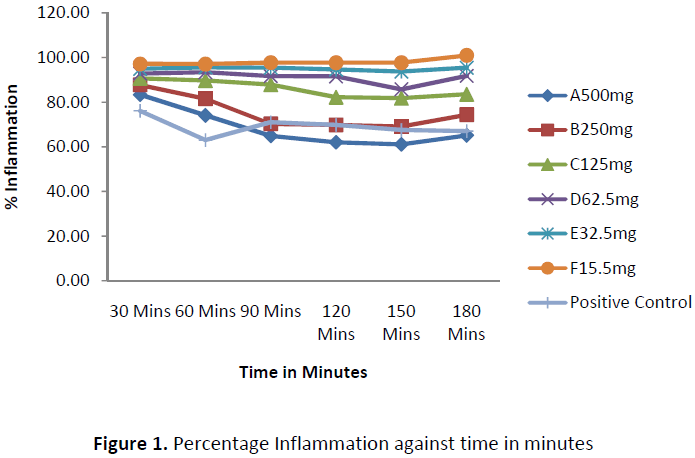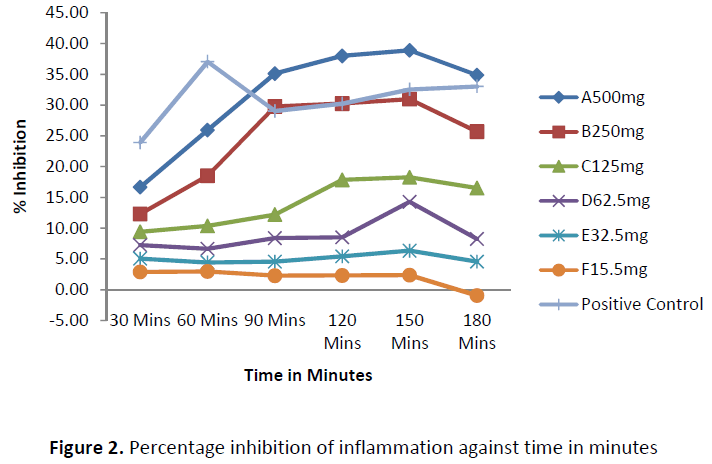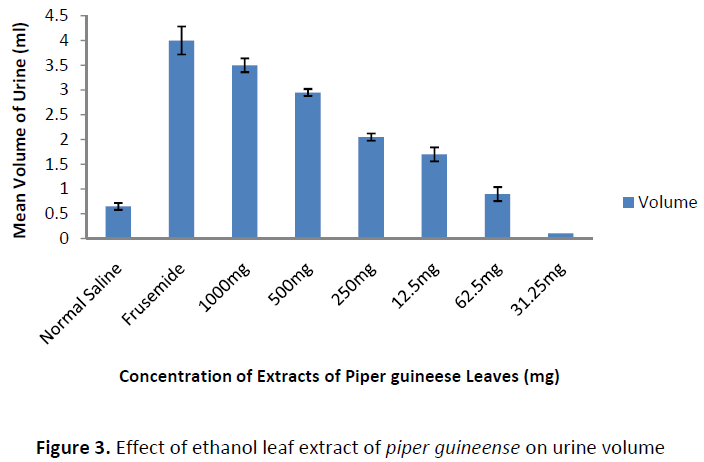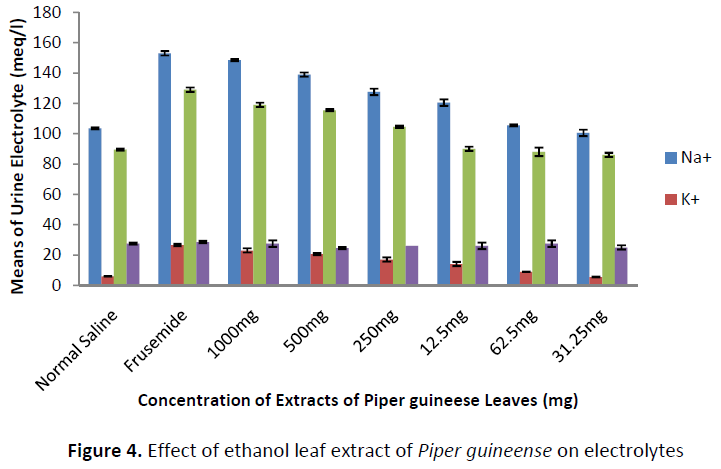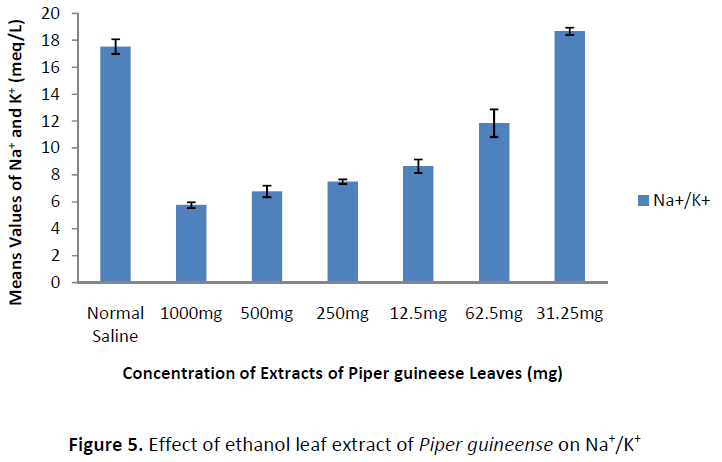Evaluation of Anti-inflammatory and Diuretic Effects of Ethanol Leaf Extract of Piper guineense on Wistar Albino Rats
1Department of Biochemistry, College of Natural Sciences, Micheal Okpara University of Agriculture Umudike, Abia State, Nigeria
2Department of Plant science and Biotecnology, College of Natural Sciences, Micheal Okpara University of Agriculture, Umudike, Abia State, Nigeria
- *Corresponding Author:
- Omodamiro O.D
Department of Biochemistry
College of Natural Sciences
Micheal Okpara University of Agriculture Umudike
Abia State, Nigeria
Abstract
Piper guineense had been widely used for its reported biological activities in indigenous system of medicine. The present study was undertaken to evaluate the anti-inflammatory and diuretic activity of ethanol leaf extract of Piper guineense on adult Wistar rats. Nine groups of two rats each was used for the study. Ethanol leaf extract of the plant was administered intra-peritoneally to the rats at doses of 15.5, 31.25, 65.5, 125, 500 and 1000mg/kg body weight respectively. Furosemide (40mg/kg) was used as positive control. The diuretic effect was evaluated by measuring the urine volume and urinary electrolyte excretion. The extract produced a significant increase in urine volume at 1000 and 500mg/kg (3.50 ± 0.14 and 2.95 ± 0.07) respectively and enhanced urinary excretion of sodium, chloride and potassium significantly (P<0.05) but had no significant effect on bicarbonate (p>0.05). The anti-inflammatory effect was evaluated on egg albumin induced paw oedema in albino rats. A negative control containing normal saline and a positive control containing 1000mg of Aspirin was used. The negative control showed a high inflammation within the time intervals while the positive control showed a low inflammation. The extract of the leaves exhibited antiinflammatory property at different time levels that was dose dependent. The average inflammation decreased as time intervals increased (5.75 ± 0.35 to 3.35 ± 0.35). The percentage inflammation decreased as interval increased (83.3 ± 0.35 to 60.1 ± 0.14), however highest inhibition was seen in the extract of highest concentration (16.6 ± 0.35) for 500mg. A significant difference (P<0.05) exists among the dose levels. These results show that ethanol leaf extract of Piper guineense has potential and significant anti-inflammatory and diuretic properties.
Keywords
Piper guineense, Diuretic, Anti-inflammatory, Ethanol leaves extract and Wistar albino rat.
INTRODUCTION
Ethnobotany and ethnomedicinal studies are today recognized as the most variable methods of identifying new medicinal plants or refocusing on those earlier reported for bioactive constituents. With the onset of research in medicine, it was concluded that plants contain active metabolites which are responsible for curative action of the herbs. Nature has provided a complete store house of remedies to cure all ailments of mankind [1his is where nature provides us with drugs in the form of herbs, plants and algae to cure the incurable disease without any toxic effect.
Medicinal plants are those plants which are rich in secondary metabolites such as alkaloids glycosides, flavonoids, steroids etc and they are important source of new chemical substances with potential therapeutic effects. They have formed the basis of traditional medicine. Nowadays, plants are important sources of medicines especially in developing countries that still use plant-based traditional medicine for their healthcare. Among the medicinal plants used, Piper guineense is used in traditional medicine for various purposes. The seeds are used in some parts of Nigeria to enhance uterine contraction after childbirth and for expulsion of placenta and other remains from the womb (2).Researchers have validated folklore claims that dry fruit and leaf extract of West African pepper could be used to boost sexual performance in men, treat sickle cell anaemia, skin discoloration and ensure mosquito free environment.
Until now the leaves of Piper guineense are used for respiratory infections and for female infertility while it fruits are used as an aphrodisiac. Previous study has shown that the aqueous extract of Piper guineense stimulates sexual behavior of male rats by decreasing mount and intromission latencies and by increasing anogenital sniffing and penile erection index (3).
Piper guineense contains large amount of beta caryophyllene which is being investigated as an anti-inflammatory agent (4).Piper guineense has been reported to have medicinal and health benefits. It is widely consumed by people but they do not know the therapeutic effect of the plant.
This scientific study is set to confirm anti-inflammatory and diuretic effects of Piper guineense. Therefore research into the pharmacological properties of this plant is expected to protect the human body from diseases such as rheumatoid arthritis, bronchitis, high blood pressure and heart failure.
MATERIALS AND METHODS
Collection of plant material
Fresh leaves of Piper guineense were purchased from Eke Itu in Ezinhitte Mbaise Local Government Area of Imo State. It was then authenticated by a Taxonomist [Dr. Omosun Garuba] of the department of Plant Science and Biotechnology Michael Okpara University of Agriculture, Umudike.
Preparation of plant extract
The plant was air dried in the plant house of Michael Okpara University of Agriculture for 28 days. It was then reduced to fine powder with Thomas Wiley Mill Model ED-5 Milling machine.
50grams of the fine powder of Piper guineense was weighed using Triple Beam Balance MB – 2610. 200ml of ethanol was added to the plant materials in a beaker. It was then allowed to stand for 72 hours at room temperature and filtered using Whatman N0 1 filter paper. The filtrate was concentrated at 50°c using Uniscope water bath, in order to evaporate the ethanol.
Experimental animals
Wistar albino mice (30-33g) and Wistar albino rats (150-200g) of either sex were used in the study. They were procured from the animal house of the department of Zoology University of Nigeria Nssuka in Nssuka Anambra State Nigeria. The animals were housed in metal cages and randomly distributed. They were kept in the University’s animal house and allowed for acclimatization period lasting for 14 days (2weeks) prior to use for any experiment. The animal ethicall committee approval was obtained before the commencement of the experiment using the wistar albino rat.
The animals had adlibtum access to clean water and standard Laboratory animal feed.
Anti-inflammatory study
The method described by Okoli C.O and Akah P.A, 2000(5) was used. A total of 24 adult albino Wistar rats of both sexes were used, they were of average weight of 150g. They were all placed in Cages and grouped into six (A-F) of 4 animals per group. They were then left to acclimatize for four days. The animals were deprived of feed for 12 hours prior to the experiment but were allowed access to pure drinking water. They were not allowed access to both feed and pure drinking water during the experiment.
The crude extract and aspirin was separately administered intra peritoneally. Group A was used as negative control thus received neither aspirin nor the crude extract. Group B received intraperitoneally 500mg/kg, Group C received 250mg/kg, group D received 125mg/kg Group E received 62.5mg/kg, Group F received 15.5mg/kg, Group G was used as positive control, thus received 100mg of aspirin intraperitoneally. The animals were left for 30minutes after which 1ml of fresh egg albumin was injected into the sub- plantar of the right hind paw of each of the rat. Using a vernier caliper, the diameter of the right hind paw was measured at 30 minutes interval of 30 minutes, 60 minutes, 90minutes, 120minutes, 150 minutes and180minutes respectively. Percentage inflammation and inhibition of inflammation were calculated using the formular below;


Diuretic activity
The method of Lipschitz et al, 1993(6) was employed for the assessment of diuretic activity. In this method, albino rats weighing about 100–150g were deprived of food and water for 10hours prior to the experiment. They were divided into 9 groups of two rats per group. The first group of animal served as negative control received Normal saline, the second group received 40mg/kg per body weight Frusemide and served as positive control. The other groups received doses of the extract at 15.5, 31.25, 62.5, 125, 250, 500 and 1000mg/kg body weight respectively. Immediately after administration, the animals were placed in metabolic cages (2 per cages) specifically designed to separate urine and faeces. The volume of the urine collected was measured at the end of 24 hours. During this period, no food and water was made available to the animals. The parameters taken were total urine volume, concentration of sodium ion, potassium ion, chloride ion and bicarbonate in the urine. Sodium and potassium ion concentration were determined by flame photometer.. Chloride and bicarbonate concentration was estimated using silver nitrate solution (using three drops of 5% potassium chromate solution as indicator.
Statistical analysis
The data obtained is expressed as mean ± standard error for the number of animals in each group (n=2).Data obtained from negative control group were used as baseline. The data obtained was analyzed by using the one-way analysis of variance (ANOVA) in all cases, statistical significance was established at values (P<0.05).
RESULTS
Anti-inflammatory activity of the plant extract
See table 1.
Table 1: Result of average inflammation of hind paw (oedema) in diameter (mm)
| Doses | 30mins | 60mins | 90mins | 120mins | 150mins | 180mins |
|---|---|---|---|---|---|---|
| 500mg/ml | 5.75±0.35 | 5.00±0.00 | 4.25±0.35 | 4.00±.42 | 3.85±3.35 | 3.55±0.35 |
| 250mg/ml | 6.05±0.07 | 5.50±0.00 | 4.60±0.00 | 4.50±0.00 | 4.35±0.07 | 4.05±0.07 |
| 125mg/ml | 6.25±0.07 | 6.05±0.07 | 5.75±0.07 | 5.30±0.14 | 5.15±0.07 | 4.55±0.07 |
| 62.5mg/ml | 6.40±0.00 | 6.30±0.00 | 6.00±0.14 | 5.90±0. 28 | 5.40±0.00 | 5.00±0.00 |
| 32.5mg/ml | 6.55±0.07 | 6.45±0.07 | 6.25±0.07 | 6.10±0.14 | 5.90±0.14 | 5.20±0.00 |
| 15.mg/ml | 6.70±0.00 | 6.55±0.07 | 6.40±0.00 | 6.30±0.00 | 6.15±0.07 | 5.50±0.14 |
| Normal saline | 6.90±0.00 | 6.75±0.07 | 6.55±0.07 | 6.45±0.07 | 4.25±0.07 | 5.45±0.07 |
| Aspirin (100mg) | 5.25±0.35 | 4.25±0.35 | 4.65±0.21 | 4.50±0.00 | 6.30±0.00 | 3.65±0.21 |
Result of percentage inflammation
See table 2.
Table 2: Result of percentage inflammation (oedema) per time intervals using non- treated animals as control
| Doses | 30mins | 60mins | 90mins | 120mins | 150mins | 180mins |
|---|---|---|---|---|---|---|
| Extract 500mg/ml | 83.3±0.35 | 74.0±0.00 | 64.8±0.35 | 62.0 ±0.42 | 61.1±0.35 | 60.1±0.35 |
| Extract 250mg/ml | 87.6±0.07 | 81.4±0.00 | 70.23±0.00 | 69.7±0.00 | 69.0±0.07 | 64.3±0.07 |
| Extract 125mg/ml | 90.5±0.07 | 89.6±.0.07 | 87.7±0.07 | 82.1±0.14 | 81.7±0.07 | 83.4±0.07 |
| Extract 62.5mg/ml | 92.7±0.00 | 93.3±0.00 | 91.6±0.14 | 91.4±0.28 | 85.7±0.00 | 91.7±0.00 |
| Extract 32.5mg/ml | 94.9±0.07 | 95.5±0.07 | 95.4±0.07 | 94.5±0.14 | 93.6±0.14 | 95.4±0.00 |
| Extract 15.5mg/ml | 97.1±0.00 | 97.0±0.07 | 97.7±0.00 | 97.6±0.00 | 97.6±0.07 | 97.7±0.00 |
| Aspirin100mg/ml | 76.0±0.35 | 62.9±0.35 | 70.9±0.21 | 69.7±0.00 | 67.4±0.07 | 66.9±0.21 |
The percentage inflammation increases as the dose level decreases and decreases as time interval increases was significant at various time intervals (p<0.05).
Result of diuretic activity
The results of screening the ethanol leaf extract of Piper guineense for diuresis are shown in table 4-5 and fig 3,4 and 5. The extract increased urine output at higher concentration of 1000 and 500mg/kg; this is similar to the diuresis obtained with frusemide which produced a significant (p<0.05) when compared with the control. Administration of the test drug significantly enhanced urinary excretion of the electrolytes and increased urine volume. The urinary excretion of the electrolytes increased as the dose concentration increased. However there was no significant difference between the treatment groups of HCO3 (p>0.05). The Na+/k+ increased as the dose levels decreased hence there was a significant difference (p<0.05) within the different dose levels.
Table 3: Result of percentage inhibition of inflammation (oedema) per time intervals
| Doses | 30mins | 60mins | 90mins | 120mins | 150mins | 180mins |
|---|---|---|---|---|---|---|
| Extract 500mg/ml | 16.6±0.35 | 25.9±0.00 | 35.1±0.35 | 37.8±0.42 | 38.8±0.35 | 39.4±0.35 |
| Extract 250mg/ml | 12.3±0.07 | 18.5±0.00 | 29.7±0.00 | 30.2±0.00 | 30.9±0.07 | 41.2±0.07 |
| Extract 125mg/ml | 9.42±0.07 | 10.3±0.07 | 12.2±0.07 | 17.8±0.14 | 18.2±0.07 | 19.3±0.15 |
| Extract62.5mg/ml | 7.24±0.00 | 6.6±0.00 | 8.4±0.14 | 8.5±0.28 | 14.2±0.00 | 16.5±0.07 |
| Extract32.5mg/ml | 5.70±0.07 | 4.4±0.0.07 | 4.5±0.07 | 5.4±0.14 | 6.3±0.14 | 6.6±0.00 |
| Extract15.5mg/ml | 2.89±0.00 | 2.9±0.07 | 2.3±0.00 | 2.3±0.00 | 2.3±0.07 | 0.0±0.14 |
| Aspirin100mg/ml | 23.9±0.35 | 37.0±0.35 | 29.0±0.21 | 30.2±0.00 | 32.5±0.07 | 33.0±0.21 |
All concentrations of tested crude extract showed remarkable inhibition of inflammation comparatively of that of aspirin and at 120minutes the degree of inhibition of the extract at 25mg/ml was exactly the same as aspirin.
Table 4: Effect of ethanol leaf extract of piper guineense on urine volume
| Samples | Volume of urine (ml/100g) |
|---|---|
| Normal saline | 0.65±0.07 |
| Frusemide | 4.00±0.28 |
| 1000mg | 3.50±0.14 |
| 500mg | 2.95±0.07 |
| 250mg | 2.05±0.07 |
| 125mg | 1.70±0.14 |
| 62.5mg | 0.90±0.14 |
| 31.25mg | 0.10±0.00 |
Table 5: Effect of ethanol leaf extract of piper guineense on urinary electrolyte excretion
| Samples | Na+ (meq/l) | K+ (meq/l) | Cl- (meq/l) | HCO3-(meq/l) | Na+/K+ Ratio |
|---|---|---|---|---|---|
| Normal saline | 103.50±0.70 | 5.90±0.14 | 89.50±0.70 | 27.50±0.70 | 17.54±5.44 |
| Frusemide | 153.00±1.41 | 26.50±0.70 | 129.00±1.41 | 28.50±0.70 | 5.77±2.12 |
| 1000mg | 148.00±0.70 | 23.00±1.41 | 119.00±1.41 | 27.50±2.12 | 6.46±0.43 |
| 500mg | 139.00±1.41 | 20.50±0.70 | 115.50±0.70 | 24.50±0.70 | 6.78±0.16 |
| 250mg | 127.50±2.12 | 17.00±1.41 | 104.50±0.70 | 26.00±0.00 | 7.51±0.50 |
| 125mg | 120.50±2.12 | 14.00±1.41 | 90.00±1.41 | 26.50±2.12 | 8.65±1.02 |
| 62.5mg | 105.50±0.70 | 8.90±0.14 | 88.00±2.82 | 27.50±2.12 | 11.85±0.26 |
| 31.25mg | 100.50±2.12 | 5.40±0.28 | 86.00±1.41 | 25.00±1.41 | 18.67±1.41 |
DISCUSSION
The most widely used primary test to screen new anti-inflammatory agents measure the ability of a compound to reduce local oedema induced in the right paw by injection of an irritant agent (Winter et al, 2002). Egg albumin induced oedema has been commonly used as an experimental animal model for inflammation.
Table 1 shows the effect of various treatment groups with regards to the mean hind paw diameter. Anti-inflammatory data for the leaf extract of Piper guineense indicated reduction in the induced edema which was significant(P<0.05)The extract suppressed inflammation, as the time intervals increased, the percentage inflammation decreased while the percentage inhibition of inflammation increased steadily thereby establishing a trend. Fig 4 clearly shows that the leaves extract administered at different dose concentrations demonstrated a good antiinflammatory activity that was dose dependent. This findings agrees with the study of anti-inflammatory activity of ethanolic extract of Citrus sinensis leaves (8).
The anti-inflammatory effect of the extract observed may be due to its phytochemical constituents such as tannins and flavonoids. This was supported by Duke, 1992 (9) that plant chemical constituents; tannins, flavonoids, saponins were proven to have anti-inflammatory effects.
Furthermore, anti-inflammatory activity has been reported by Menthey et al,2001(10) that flavonoids inhibits phosphodiesterases which are involved in cell activation in the biosynthesis of protein kinases which the extract exerts its antiinflammatory effects, since the plant was earlier reported by Echo et al, 2012 (11) to contain phytochemicals namely; Alkaloids, flavonoids, tannins, terpens, steroids, glycosides which was confirmed by preliminary phytochemical screening carried out on the plant extract.
Inflammation is caused by the release of chemicals from tissues and migrating cells. Most strongly implicated are the prostaglandins, (PGs), Leukotrienes (LTs), Histamine and bradykinin and more recently, platelet – activating factor (PAF) and inter-leukin – 1. Inflammatory drugs, which inhibit the cyclo-oxygenase, enzyme and reduce synthesis of prostanoids corticosteroids prevent the formation of both PGs and LTs by causing the release of lipocortin, which by inhibition of phospholipase A2, reduces arachidonic acid release. They suppress the inflammation of rheumatoid arthritis and asthma.
Non-steroidal anti-inflammatory drugs produce their therapeutic activities through inhibition of cyclo-oxygenase (COX), the enzyme that is involved in prostaglandin-biosynthesis. COX has two isoenzymes (COX – 1 and COX – 2). COX – 2 induced by inflammatory stimuli such as cytokines, and produces prostaglandins that contribute to the pain and swelling of inflammation.
Immune Steroid anti-inflammatory drugs alter the activation and migration of inflammatory cells which are immune cells responsible for amplifying the inflammatory response (12).
The glucocorticoids are class of steroids that reduce inflammation by binding to glucocorticoid receptors. The activated glucocorticoid receptors. The activated glucocorticoid receptor regulates the expression of anti-inflammatory protein in the nucleus and represses the expression of pro-inflammatory proteins in the cytosol. (13). They inhibit the production of inflammatory mediators such as prostaglandin.
As revealed in the diuretic activity in this study, the evidence of the diuretic response was observed in rats treated with Frusemide and the plant extract. The leaves of Piper guineense significantly increased urine volume at high doses of 1000mg/ml and500mg/ml and also enhanced urinary electrolyte excretion.
Frusemide inhibits electrolyte reabsorption in the thick ascending loop of the nephron which leads to retention of water in the urine .It is a loop diuretic and hence acts as on the Na+K+Cl-symporter. It inhibits Na+ and Cl- reabsorption, it was observed that there was increase in Na+ and Cl- excretion.
Treatment with doses of 1000 and 500mg/kg body weight produced significant diuresis in treated animals; there was a greater excretion of Na+ with the 1000,500 and 500mg/kg doses of the extract than with the lower doses of 125, 62.5 and 31.25mg/kg body weight which gave a greater depletion of potassium.
This suggests that an increase in the dose of the extract can lead to hypokalemic alkalosis but with lower dose can lead to hyponatremia. Higher doses can also lead to hypernatremia. There was also significant increase in the total chloride excretion in all doses of the extract compared to the test drug Frusemide that is the Chloride content was much higher than Frusemide treated animals. The bicarbonate content was almost the same within the groups. The low level of bicarbonate among the treatment groups indicates that the extract suppresses the activity of the enzyme carbonic anhydrase, which converts carbon-dioxide and water to carbonic acid. Carbonic anhydrase inhibitors inhibit the transport of HCO3- out of the proximal convoluted tubule into the interstitum which leads to less sodium reabsorption and causing greater sodium, bicarbonate and water loss in urine. (14,15). Carbonic anhydrase inhibitors lead to hypokalemia and metabolic acidosis. Low bicarbonate level indicates metabolic acidosis. The Na+/K+ levels increased as the dose levels decreased therefore lower doses of the extract may lead to cardiovascular diseases and kidney dysfunctions since sodium and potassium help the kidney to function properly, important to energy production and fluid balance.
The leaf extract of Piper guineense may have similar mechanism of action to the potassium sparing diuretics that do not promote secretion of potassium into the urine.
The presence of saponin in the phytochemical screening may also have contributed to the diuretic effect. As saponin have been reported to be involved in plant diuretic responses.
CONCLUSION
From this investigation, the different doses of the extract showed that Piper guineense leaf possesses significant antiinflammatory and diuretic properties. The study has shown the leaves of Piper guineense which was used as a spice can also serve as anti-inflammatory and diuretic agents.
The continual search for the interest in natural products used as drugs has acted as the catalyst for exploring methodologies involved in obtaining the required plant materials. I therefore recommend that further studies should be carried out on the plant to isolate active constituents responsible for its anti-inflammatory and diuretic activities and also explore its exact mechanism of action responsible for its antiinflammatory and diuretic activities.
REFERENCES
- Kokata, T. (2002): “Some Plants of Ethnomedicinal importance From Dangel District, West Benghal”. Journal of Taxonomic Botany.27, 972-977.
- Udoh, F.V, Theodore, Y.L, Braide, V.B. (2009): ”Effects of extracts of seeds and leaf of Piper guineense on skeletal muscle activity in rats and frog”. Phytother Res. p110.
- Mbongue, F.G., Kantchanining, O.J, Essame, P.M, Diine,. T. Lontsi, D. (2005): “Effect of the aqueous extract of Dry Fruits of Piper guineense on reproductive function of adult Male Rats”. Indian Journal of Pharmacol Methanolic Extract of Piper guineense Leaf on uterine Physiology, Pharmacologia. 45(3), 200-23.
- Ghelardin, C, Galeolfi, N, Cesare, D,, Mazzanti, G. (2001):” Local anaesthetic activity of /3 −Caryophyllene”. Farmaco. 56(7), 389-9.
- 5] Okoli, C.O and Akah, P.A (2000). A pilot evaluation of the anti-inflammatory activity of culcastascardens, a traditional antasth- maticagent. Journal of alternative and complementary medicine vol.6:pp423-427.
- Lipschitz, W.L, Hadidan, Kerpcer, A. (1943): Bioassay of diuretics. J. Pharmacol Exp and Ther. 79,97-110.
- Winter, C.A and Risley, E.A. (2002):”Egg albumin induced oedema in the hind paw of rat as an assay for anti-inflammatory drug”. procsoc. Expel Biol Med, III.544.
- Omodamiro, O.D and Umekwe, J.C. (2013): ”Evaluation of anti-inflammatory, antibacterial and antioxidant properties of ethanolic extracts of Citrus sinensis peel and leaves”. Jorunal of Chemical and Pharmaceutical Research. 5(5), 56-66.
- Duke, J.A. (1992): Handbook of Biologically active phytochemicals and their activities. CRC Press, BOCA Ration FL.pp.12-15.
- Menthey, J.A, Grohamanu, K, Guthric, N. (2001): Curr. Med Chem, 8, 135-153.
- Echo, I.A, Osuagwu, A.N, Agbor, A.B, Okpako, E.C, Ekanem, B.E. (2012): ”Phytochemical composition of Aframomum melegueta and Piper guineenseseeds.”World Journal of Applied Enviromental Chemistry. 2(1), 17-21.
- Bao, F, John, S.M, Chen, Y, Mathison, R.D, Weaver, L. (2006): ”The tripeptide phenyalanine (d), glutamate (d), gycine modulates leukocyte infiltration and oxidative damage in rat injured spinal”. Neuroscience. 140(3), 1011-1022.
- Rhen, T, Cidlowski, J.A. (2009):”Anti- infllammatory action of Glucocorticoids. New Mechanism for old drugs”. N. Engl. J. Med. 353(16), 1711-23.
- Supuran, C.T, Scozzafava, A, Casihi, A. (2003): ”Carbonic anhydrase Inhibitors”. Med Res Rev. 23(2), 146-89.
- Sudipta, Dax Pallab, K, Haldar, Goutam, Pramanik, Suresh R.B. (2010):” Evaluation of Antin-inflammatory Activity of Clerodendon Infortunatum Linn. Extract in Rats”. Global Journal of Pharmacology. 4(1), 48-50.
Open Access Journals
- Aquaculture & Veterinary Science
- Chemistry & Chemical Sciences
- Clinical Sciences
- Engineering
- General Science
- Genetics & Molecular Biology
- Health Care & Nursing
- Immunology & Microbiology
- Materials Science
- Mathematics & Physics
- Medical Sciences
- Neurology & Psychiatry
- Oncology & Cancer Science
- Pharmaceutical Sciences
